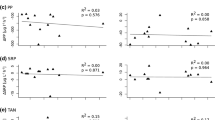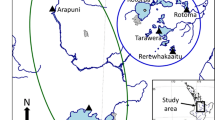Abstract
The productivity and ecological role of benthos in man-made Lake Kariba was assessed through the use of P/B-ratios and by measuring the metabolism (respiration, N and P excretion) of the most abundant mussel species (Aspatharia wahlbergi, Corbicula africana and Caelatura mossambicensis) in laboratory experiments. For A. wahlbergi also filtration rate was estimated.
The annual production of benthos for the populated 0–12 m interval was estimated at 11.0 g m −2 yr−1 (shellfree dry weight) of which mussels contributed for 8.81 g (80%), snails 2.16 g (20%) and insects 0.03 g (0.3%) respectively. The most important mussel species in the lake were Caelatura mossambicensis (4.97 g m−2 yr−1) and Corbicula africana (3.33 g). The dominant snail species was Melanoides tuberculata (1.63 g). For the total lake, also including deeper unpopulated bottoms, the annual production of benthos was 2.70 g m−2 yr−1 (shell-free dry weight).
Respiration and excretion varied with temperature displaying a bell-shaped relationship. Metabolic rates in Aspatharia wahlbergi increased about 5× between 16.5 °C and the maximum at 34.0 °C and then decreased again at 39.0 °C, when the mussels showed signs of severe stress. Metabolism in Corbicula africana had a lower optimum with fairly constant activity between 18.6 and 29.2 °C, rapidly decreasing above this temperature.
The average respiration, nutrient excretion and water filtration rates for mussels in Lake Kariba at 25.2 °C were estimated to about 0.6 mg O2 85 µg NH4−N, 1.5 µg PO4−P and 0.51 water filtered h−1 g−1 shellfree dry weight. This gives that a volume corresponding to about the total epilimnion of the lake is filtered by the mussels annually. Further, mussels can be estimated to remineralise % MathType!MTEF!2!1!+-% feaafiart1ev1aaatCvAUfeBSjuyZL2yd9gzLbvyNv2CaerbuLwBLn% hiov2DGi1BTfMBaeXatLxBI9gBaerbd9wDYLwzYbItLDharqqtubsr% 4rNCHbGeaGak0Jf9crFfpeea0xh9v8qiW7rqqrFfpeea0xe9Lq-Jc9% vqaqpepm0xbba9pwe9Q8fs0-yqaqpepae9pg0FirpepeKkFr0xfr-x% fr-xb9adbaqaaeGaciGaaiaabeqaamaabaabaaGcbaGaaGymaiaac+% cacaaI0aaaaa!3A2B!\[1/4\] of the total load of phosphate, and 8 times the total load of nitrogen every year. The population needs 3.5 × 104 tons of organic carbon for its maintainance, which indicates that about 5% of the annual phytoplankton production is channeled through mussels. We conclude that the mussels, rather than being an important food source for fish, seem to play a large role in the nutrient dynamics of Lake Kariba.
Similar content being viewed by others

References
Balon, E. K., 1978. The dubious benefits of large dams. Ambio 7: 39–48.
Balon, E. K. & A. G. Coche, 1974. Lake Kariba: A man-made tropical ecosystem in Central Africa. Junk Publishers, The Hague, 758 pp.
Beadle, L. C., 1981. The inland waters of tropical Africa. Longman Group Ltd.. Longman House, London.
Begg, G. C., 1970. Limnological observation in Lake Kariba during 1967 with emphasis on special features. Limnol. Oceanogr. 15: 776–788.
Carlberg, S. (ed.), 1972. New Baltic Manual. ICES Cooperative Res. Rep. Ser. A, No. 29.
Carmouze, J. P., J. R. Durand & C. Leveque, 1983. Lake Chad, ecology and productivity of a shallow tropical ecosystem. Junk Publishers, The Hague, 518 pp.
Clarke, B. C. & C. L. Griffiths, 1990. Ecological energetics of mussels Choromytilus meridionalis under simulated intertidal rock pool conditions. J. Exp. Mar. Biol. Ecol. 137: 63–77.
Cockcroft, A. C., 1990. Nitrogen excretion by surf zone bivalves Donax serra and D. sordidus. Mar. Ecol. Prog. Ser. 60: 57–65.
Dame, R., H. Zingmark, H. Stevenson & D. Nelson, 1980. Filter feeding coupling between the estuarine water column and benthic subsystems. In Kennedy V. S. (ed.), Estuarine perspectives. Academic Press, New York, 521–526.
Davies, B. R. & R. C. Hart, 1981. Invertebrates. In Symoens, J. J., M. Burgis & J. J. Gaudet (eds), The ecology and utilization of African inland waters. United Nations Environment Programme.
Fisher, T. R. & P. E. Parslev, 1979. Amazon lakes: water storage and nurrient shipping by algae. Limnol Oceanogr. 24: 547–553.
Foe, C. & A. Knight, 1986. A thermal budget for juvenile Corbicula fluminea. Proceedings of the second international Corbicula Symposium, Am. Malacol. Bull. Special Edition no 2: 143–150.
Golterman, H. L., 1975. Chemistry. In Whitton, B. A. (ed), River ecology, Oxford. Blackwell: 39–80.
Hart, R. C, 1980. Oxygen consumption in Caridina niolotica (Decapoda: Atyiidae) in relation to temperature and size. Freshwat., Biol. 10.
James, M. R, 1987. Ecology of the freshwater mussel Hydriella menziesi (Gray) in a small oligotrophic lake. Arch. Hydrobiol. 3: 337–348.
Kautsky, N. & S. Evans, 1987. Biodeposition of Mytilus edulis and its role in the circulation of energy and matter in a Baltic coastal ecosystem. Mar. Ecol. Prog. Ser. 38: 201–212.
Kautsky, N. & M. Kiibus. Biomass, ecology and production of benthic fauna in Lake Kariba. In: Moreau, J. (ed). Ecology of Lake Kariba, in press.
Kautsky, N. & I. Wallentinus, 1980. Nutrient release from a Baltic Mytilus — red algal community and its role in benthic and pelagic productivity. Ophelia, Suppl. 1: 17–30.
Kenmuir, D. H. S, 1980. Aspects of the biology and population dynamics of freshwater mussels in Lake Kariba and Lake McIlwaine. Lake Kariba Fisheries Research Institute Projec Report, 36. Ph.D. Thesis, University of Natal, South Africa.
Lewandowski, K. & A. Stanczykowska, 1975. The occurence and role of bivalves of the family Unionidae in Miklajskie Lake. Ekol. Pol. 23: 317–334.
Lévěque, C., C. Dejoux & L. Lauzanne, 1983. The benthic fauna: ecology, biomass and communities. In Carmouze J. P., J. R. Durand & C. Lévêque (eds), Lake Chad, ecology and productivity of a shallow tropical ecosystem. Junk Publishers, The Hague: 233–272.
Lévěque, C., J. R. Durand & J. M. Ecoutin, 1977. Relations entre le rapport P/B et la longévité des organismes. Cah. ORSTROM Ser. Hydrobiol. 11: 17–32 (in French).
Lévěque, C. & L. Saint-Jean. 1983. Secondary production (zooplankton and benthos). In Carmouze J. P., J. R. Durand & C. Lévêque (eds) Lake Chad, ecology and productivity of a shallow tropical ecosystem. Dr W. Junk Publishers, The Hague: 357–384.
Machena, C., 1989. Ecology of the hydrolittoral macrophyte communities in Lake Kariba, Zimbabwe. PhD thesis. Akademitryck. Uppsala university.
Machena, C. & N. Kautsky, 1988. A quantitative diving survey of benthic vegetation and fauna in Lake Kariba. a tropical man made lake. Freshwat. Biol. 19: 1–14.
Machena, C.. J. Kolding & R. Sanyanga, 1993. A preliminary assessment of the trophic structure of Lake Kariba, Africa; In Christensen, V. & D. Pauly (eds), Trophic models of aquatic ecosystems. ICLARM Conf. Proc. 26, 390 pp.
Magadza, C. H. D, A. Heinanen & E. J. Dhlomo, 1989. Some preliminary results on the limnochemistry of Lake Kariba, 1986, with special reference to Nitrogen and Phosphorous. In Magadza. C. H. D (ed.), ULKRS Bulletin No 1/89, Ecology of Lake Kariba. University of Zimbabwe Lake Kariba Research Station.
McLachlan, A. J., 1969. The effect of aquatic macrophytes on the variety and abundance of benthic fauna in a newly-created lake in the tropics (Lake Kariba). Arch. Hydrobiol. 66: 212–231.
McMahon, R. F., 1979. Response to temperature and hypoxia in the oxygen consumption of the introduced Asiatic freshwater clam Corbicula fluminea (Muller). Comp. Biochem. Physiol., 63A: 383–388.
Nalepa, T. F., W. S. Gardner & J. M. Malczyk. 1991. Phosporous cycling by mussels (Unionidae:Bivalvia) in Lake St. Clair. Hydrobiologia 219: 239–250.
Odum, E. P., 1971. Fundamentals of ecology W. B. Saunders Company. 574 pp.
Perez-Carnacho, A. & R. Gonzalez, 1984. The filtration rate of mussel (Mytilus edulis L.) in the laboratory. Proceedings of the first seminar on marine sciences: The Galician ‘rias’, Vigo, 10, 11 and 12 March 1983. Seminario de Estudos Galegos, A Coruna Spain 427–437. (in Spanish, summary in English).
Peters. R. H. & S. Macintyre, 1976. Orthophosphate turnover in East African lakes. Oecologia (Bert.) 25: 313–319.
Ramberg, L., S. Bjork-Ramberg, N. Kautsky & C. Machena, 1987. Development and biological status of Lake Kariba — a man-made tropical lake. Ambio 6: 314–321.
Rodriguez-Ortega, D. & J. W. Day, Jr, 1978. An ecological study of Modiolus demissus granossissimus. Sowerby in Louisiana (USA). An. Cent. Cienc. Mar. Limnol. Iniv. Nac. Auton. Mex., 5: 215–224.
Stanczykowska, A. W. Lawacz. I. Mattice & K. Lewandowski, 1976. Bivalves as a factor effecting circulation of matter in Lake Mikolajskie (Poland). Limnologica (Berlin) 10: 347–352.
Stanczykowska, A. & M. Planter, 1985. Factors affecting nutrient budget in lakes of the R. Jorka watershed (Masurian Lakeland, Poland). 1. Role of the mussel Dreissena polymorpha (Pall.) in N and P cycles in a lake ecosystem. Ekol. Pol. 33: 345–356.
Tedengren, M., C. André, K. Johannesson & N. Kautsky, 1990. Genotypic and phenotypic differences between Baltic and North Sea populations of Mytilus edulis evaluated through reciprocal transplantations. 3. Physiology. Mar. Ecol. Prog. Ser. 59: 221–229.
Walz, V. N., 1978. Die Produktion der Dreissena-Population und deren Bedeutung im Stoffkreislauf des Bodensees. Arch. Hydrobiol. 82: 482–499. (in German).
Vareschi, E. & J. Jacobs 1984. The ecology of Lake Nakuru (Kenya). V. Production and consumption of consumer organisms. Oecologia, 61: 83–98.
Winberg, G. G., K. Patalas, J. C. Wright. A. Hillbricht - Ilkowska, W. E. Cooper & K. H. Mann, 1971. Methods for calculating productivity. In Edmonson, W.T. & G. G. Winberg, (eds). Secondary productivity in fresh waters. I.B.P. Handbook No, 17 Blackwell Scientific Publications, Oxford and Edingburgh.
Zaika, V. E., 1973. Specific production of aquatic invertebrates. John Wiley and Sons, New York and Toronto.
Author information
Authors and Affiliations
Rights and permissions
About this article
Cite this article
Kiibus, M., Kautsky, N. Respiration, nutrient excretion and filtration rate of tropical freshwater mussels and their contribution to production and energy flow in Lake Kariba, Zimbabwe. Hydrobiologia 331, 25–32 (1996). https://doi.org/10.1007/BF00025404
Received:
Revised:
Accepted:
Issue Date:
DOI: https://doi.org/10.1007/BF00025404



